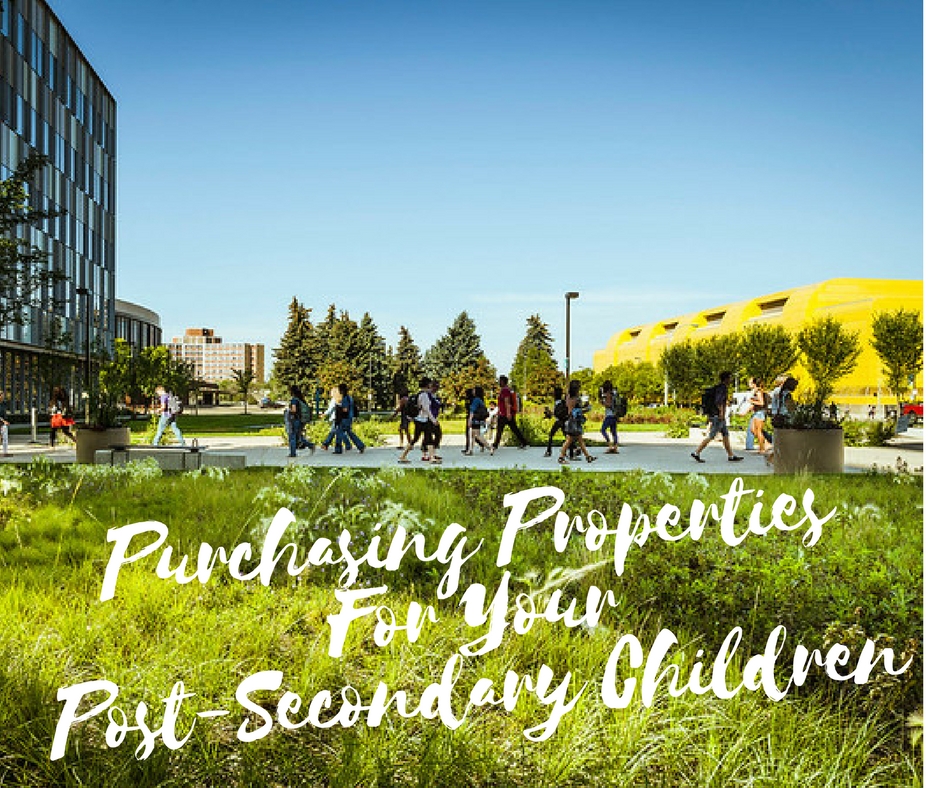Purchasing Properties for Your Post-Secondary School Children

Does your child plan to attend a post-secondary institution once they graduate from high school? If the answer is yes, then it’s never too early to start thinking about purchasing an Edmonton investment property they can live in while attending school.
Whether you are looking for a second property you can rent to family, or you desire a well-maintained home your children can live in (and you can visit!) while attending college or university – there are a variety of options available in many central Edmonton neighbourhoods.
Step One: Determine Your Budget
There are a host of variables at play when choosing the right property, so determining your budget from the get-go will help you zero-in on finding the perfect place.
Remember that properties closer to post-secondary institutions are often easier to rent, which also makes them more expensive to buy. So if price is a concern, consider looking for places on direct transit routes within a reasonable commute from the school. This will increase your options and provide more opportunities for getting a better deal.
Another factor to remember is to budget between $300-500 per month for condo fees.
If close proximity to school is more important than the price point, try looking for places built with solid construction and multiple bedrooms close to your preferred post-secondary institution. Properties with well-maintained character and curb appeal will help set you apart from other market properties when the time comes down the road to sell.
Step Two: Map the Commute
Again, it is always a great idea to purchase housing for post-secondary students close to major transit routes. This will increase the chances of finding other student tenants if your child will have roommates.
Surprisingly a typical commute using transit in certain neighbourhoods can be shorter than driving and parking. Google Maps is an excellent resource for verifying a true commute time. For example, Queen Mary Park is a 20 minute transit commute to the U of A compared to a 30 minute commute from Ritchie – even though they are on opposite sides of the river.
Step Three: Identify Parking Needs
If you are in need of permanent parking, remember that heated and underground parking can add some extra costs to the purchase price. However it may be a gain when it comes to resale. You can find some good deals in older and smaller buildings with outdoor parking. If it is a house with an older garage, you might want to consider rebuilding a garage suite to add more value and rental opportunities to your investment property, while also solving any covered parking needs
If you plan to buy a condo, determine if an elevator is essential, as this will help you focus your search.
Step Four: Elbow Grease + Creativity = Good Value
If you have the skills, doing cosmetic improvements and renovations as a family can save a lot of money, and will also give your child the opportunity to personalize his/her space. Look for properties that could really be improved with some new flooring, paint, and modern light fixtures. Not only will you get some added-value down the road, it could also turn out to be a really memorable bonding exercise with your adult (or soon-to-be-adult) child.
Step Five: Make Some Room For Sharing
When it comes to bedrooms, it is always a great idea to have at least one extra bedroom for a potential roommate, and even more if you plan to visit often, or if you have multiple children who plan to share the home.
It’s helpful to look for properties with bedroom layouts that have more privacy between bedrooms. Other “must-haves” include a functional kitchen with adequate storage space, and at least one bright and spacious communal space. In-suite laundry that is organized for shared use can be a real bonus for busy post-secondary students.
Step Six: Identify House Rules Before Move-In
Once you have purchased the property, sit down with your child (or children) and discuss expectations of the living arrangements prior to them moving in. Writing out the rules, terms of agreement and expectations will help keep everyone on the same page and will reduce conflict and misunderstandings.
Here are a list of some relevant topics for conversation:
- Is the housing only available while the child is attending school?
- What will the rent be and when and how should it be paid?
- Will a security deposit be required? How about for roommates?
- Who gets to decide the appropriate roommates?
- Are overnight visitors allowed?
- Who will take care of renovations and fixing problems?
- Who will pay for the utilities and maintain any outdoor spaces?
- What are the rules for parents stopping by and entering property?
- Are romantic partners allowed to move in? Will they need to pay rent, and how much?
- What are the building by-laws regarding pets, smoking, children and long-term visitors?
If you are considering purchasing a property for your child or children attending an Edmonton post-secondary institution, the TruHome team can help you choose the best options when it comes to condos and homes in some of these Central Edmonton communities: Downtown | Oliver | Queen Mary Park | Garneau | Strathcona | Ritchie

